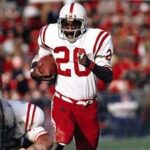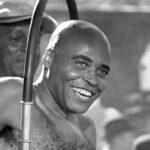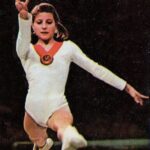Losers No More: The Rise of the New Orleans Saints
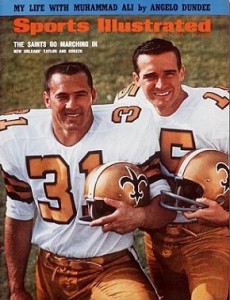
Hall of Fame running back Jim Taylor and quarterback Gary Cuozzo were members of the originals Saints.
On the first play in New Orleans Saints history, rookie John Gilliam returned a kickoff 94 yards against the Los Angeles Rams for the first touchdown in franchise history. Little did anyone watching that game on September 17, 1967 know that it would take 43 years before the promise of that opening day would culminate with an appearance in football’s grandest game.
The road from opening kickoff to Super Bowl XLIV has been long and full of disappointment, but much like the city it represents, the Saints have withstood every trial and now are just one victory from being crowned Super Bowl Champions.
Despite the opening fireworks, that opening game did provide a glimpse into what was in store for Saints fans. The Rams recovered to hold the Saints to just two field goals the rest of the way while coming back for a 27-13 victory.
The Saints won three games during their opening season with their first win coming in the eighth week of the season against the Philadelphia Eagles.
During the early years, the Saints were a haven for “has beens” and “never weres”.
The opening roster included a pair of future Hall of Famers in Jim Taylor and Doug Atkins, but both players were at the end of their careers and only shells of their former selves.

The 63-yard field goal by Tom Dempsey in 1970 was one of the few bright moments for the Saints during their early years.
A total of 19 rookies also dotted the roster for the Saints in 1967. A couple of these youngsters (most notably a pair of receivers in Gilliam and Danny Abramowicz ) would go on to NFL stardom, but most are little more than NFL footnotes.
The first coach was Hall of Fame receiver Tom Fears, but the former Los Angeles Rams star proved to be better at running patterns than calling plays. He went 13-34 before being fired midway through the 1970 season.
Perhaps the greatest highlight of the first few seasons in New Orleans was the record 63-yard field goal by kicker Tom Dempsey against the Detroit Lions during the 1970 season. It was a brief flirtation with greatness during a time when the Saints struggled for relevance.
The 1971 season brought to New Orleans a player who would come to epitomize the struggles of the franchise.
The second overall pick in the 1971 NFL Draft out of the Ole Miss, Archie Manning instantly became a hometown favorite. His energy and athleticism brought excitement to old Tulane Stadium.
Unfortunately, his talent didn’t translate into additional victories. The Saints won only 15 of his 61 starts between 1971 and 1975. Manning was sacked an amazing 186 times in those five years while tossing 47 touchdowns and 78 interceptions.
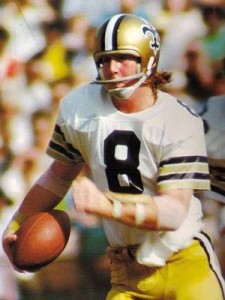
Archie Manning was the face of the Saints for more than a decade.
In 1976 the Saints looked to turn around their dismal fortunes by bringing former Super Bowl coach (and future Hall of Famer) Hank Stram to New Orleans. However, any hope for resurgence was squashed when Manning was injured and missed the entire 1976 season while Stram guided the team to a 4-10 record.
The next season, Manning returned, but it didn’t help as New Orleans went 3-11 for their sixth double digit losing season in 11 seasons.
Under new head coach Dick Nolan in 1978, Manning and the Saints began to turn things around. Manning was selected to the Pro Bowl as the Saints went 7-9 for the best season in team history.
In 1979 New Orleans overcame a 0-3 start to finish with an 8-8 record for the first non-losing season in team history. In addition to Manning, running back Chuck Muncie, wide receiver Wes Chandler, tight end Henry Childs and safety Tom Myers all were named to the NFC Pro Bowl squad.
The first Pro Bowl ever played in Hawaii proved to be a coming out party for the Saints as Archie Manning tossed a touchdown pass and Chuck Muncie was named the game MVP.
With so many emerging superstars, it appeared that the future was bright for the Saints.
However, in what would become a repeating story line for the Saints over the decades, just when it looked like good things were going to happen, the sky fell in.
New Orleans again started slow in 1980, but this time they did not recover. The Saints lost their first 14 games, the 14th being a disheartening 38-35 loss to Joe Montana and the San Francisco 49ers in a game the Saints led 35-7 at halftime.
They managed to defeat the New York Jets 21-20 in week 15 to avoid being the first NFL team to lose 16 games in a season.
The promise from just a year earlier was now gone and when favorite son Archie Manning was traded to Houston after the first game of the 1982 season all five of the Pro Bowl Saints from 1979 were gone.
Manning was replaced at quarterback by former Super Bowl champion Ken Stabler and for a brief moment it looked like Stabler and new head coach Bum Phillips might lead the Saints to the promised land.
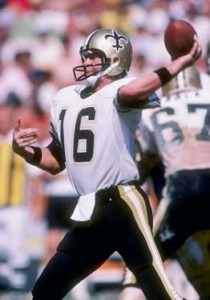
Ken Stabler came close to leading the Saints to the playoffs in 1983.
New Orleans needed a victory in the final game of the 1983 season to record the first winning season in team history and earn a trip to the playoffs. The Saints led 24-23 before Los Angeles Rams kicker Mike Lansford kicked the game-winning field goal to lift the Rams to a 26-24 victory and a spot in the playoffs.
The Saints were again unable to build on their brush with success as they went 7-9 and 5-11 the next two seasons before Phillips exited.
Entering the door in 1986 was a young coach that had enjoyed success coaching in the USFL. Jim Mora was a confident coach who brought a sense of pride and confidence to the franchise that was different than what New Orleans had ever seen before.
After flirting with a winning record while ultimately finishing 7-9 in 1986, the Saints broke down the door in 1987 for their first winning season in their 21 year history. With a 12-3 record, the Saints earned the right to host a playoff game for the first time in NFL history.
The New Orleans Superdome has hosted more Super Bowls than any other stadium, but the excitement around the first playoff game in the history of the hometown team was even greater than for the Super Bowls.
Facing a Minnesota Vikings team that had finished with an 8-7 record and barely reached the playoffs, expectations were high for the Saints.
Unfortunately, the New Orleans luck soon came into play and the greatest day in franchise history became the most disappointing. The Saints didn’t just lose, they were dominated 44-10.
The loss stunned the franchise and even though they posted winning records in each of the next two seasons, they were unable to return to the playoffs.
They finally earned a return trip to the playoffs with an 8-8 record in 1990, but were quickly dispatched from the playoffs by the Chicago Bears.
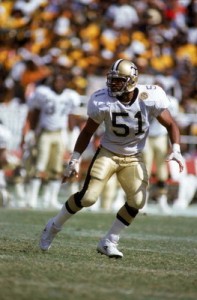
Sam Mills was the defensive leader of the Saints during the late 1980s and early 1990s.
The Saints of the late 1980s and early 1990s were a team focused on defense and led by one of the great linebacker units in NFL history. Rickey Jackson, Sam Mills, Vaughan Johnson and Pat Swilling all earned at least four Pro Bowl trips during their careers and combined for a total of 21 Pro Bowl appearances.
Offensively the Saints relied on the running of Dalton Hilliard, Rueben Mayes and Craig “Ironhead” Heyward. The primary quarterback during the era was Baton Rogue native Bobby Hebert, who went 46-20 as a starter between 1987 and 1992.
The Saints started the 1991 season with seven straight victories and the following season finished with a 12-4 record. However, both seasons ended with disappointing opening round home playoff losses.
By 1993 the window had closed on Mora and the Saints and they struggled for the remainder of the decade.
In 1997 they followed the same path they had done previously with Hank Stram and Bum Phillips by bringing in a coach with a championship pedigree in Mike Ditka.
Unfortunately, the results were again underwhelming as the Saints went 15-33 in Ditka’s three seasons at the helm.
In 2000, Jim Haslett took over the coaching reigns and in his first season led the surprising Saints to a 10-6 record and trip to the playoffs.
Led by quarterback Aaron Brooks, running back Ricky Williams and receiver Joe Horn the Saints finally were able to get over the playoff threshold.
Hosting the defending Super Bowl Champion St. Louis Rams, the Saints out-scored the “Greatest Show on Turf” in a 31-28 victory. They lost the next week to their playoff nemesis the Minnesota Vikings, but the future seemed bright for Haslett and his talented young squad.
However, expectations again gave way to reality as the Saints finished 7-9, 9-7 or 8-8 in each of the next four seasons and were never able to return to the playoffs.
Hurricane Katrina devastated New Orleans just days before the start of the 2005 season, forcing the team to do as did many other area residents and flea for other cities.
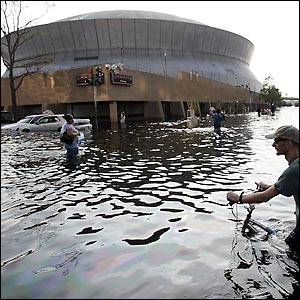
In the aftermath of Hurricane Katrina there were questions as to whether the Saints would ever return to New Orleans.
The Saints played their first “home game” of the season at Giants Stadium against the Giants during the second week of the season. They then split their remaining home games between Tiger Stadium in Baton Rogue and the Alamodome in San Antonio while winning only three games.
Given the decimation in New Orleans, there were real questions as to whether the Saints would ever return home.
Even as other work in the city was just getting started, turning the Superdome back into a quality NFL Stadium and bringing home the Saints became early priorities in the city.
Just slightly more than one year after Hurricane Katrina, the Saints made an emotional return to New Orleans.
While the Saints had always enjoyed a loyal following, a special bond was forming between the team and the fans. The Saints fed off the emotion of the city and under the guidance of first year head coach Sean Payton posted a 10-6 record to win their division and earn a first round playoff bye.
After dispatching the Philadelphia Eagles 27-24 in the second round of the playoffs, the Saints made their first-ever trip to the NFC Championship Game.
Though they lost to the Bears 39-14, everyone in New Orleans was excited about the return of the team and the bright future that seemed to lie ahead.
Repeating their tendencies of the previous four decades, the Saints took a step backward over the next two seasons finishing with records of 7-9 and 8-8 despite having one of the best quarterbacks in the league in Drew Brees and a solid running game that featured all-time team rushing leader Deuce McAllister.
By 2009 few believed that the Saints could put things together for a championship push.
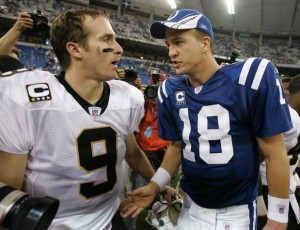
Super Bowl XLIV will match current New Orleans hero Drew Brees against the youngster who grew up watching his dad play quarterback for the Saints, Peyton Manning.
However, they scored 93 points in their first two games and suddenly looked like an unstoppable offense.
New Orleans rolled off a franchise record 13 straight wins to start the season before dropping their last three regular season games after they had sealed home field advantage.
Previous New Orleans teams might have folded in their initial playoff game against the defending NFC Champion Arizona Cardinals. However, this time things were different for the Saints.
They spotted Arizona an early touchdown and then went on to a dominating 45-14 victory. Much maligned running back Reggie Bush punctuated the victory with an 83 yard punt return to account for the final score.
The victory put New Orleans in the NFC title game for the second time in four years, but this time the game was in New Orleans.
At long last, the stadium that has seen some of the great moments in sports history would be hosting its hometown team with a Super Bowl spot on the line.
In a full-circle moment, the foe in the NFC Championship Game was the Minnesota Vikings, the same team that had embarrassed the Saints in their first-ever playoff game.
This time there would be no embarrassment on either side. The two teams spent the entire game lobbing tomahawk shots at each other, but both refused to fall.
Finally, with the game tied and time running down, it looked like the Vikings were going to snatch victory from the Saints.
Minnesota reached the New Orleans 32-yard line and looked poised to line up for the game winning field goal. However, a penalty knocked them out of range and suddenly quarterback Brett Favre felt the need to throw the ball and get more yards for his kicker.
In a divine intervention for the Saints, Favre’s pass was intercepted by Tracy Porter to send the game into overtime.
New Orleans won the toss and quickly seized control. Brees led the team down the field and kicker Garrett Hartley nailed a 40-yard kick to lift the Saints to their first Super Bowl.
As fate would have it, the first-ever Super Bowl appearance for the Saints pits them with a quarterback whose name is still synonymous with the New Orleans Saints.
Peyton Manning grew up living in New Orleans and watching his father quarterback the Saints. On Sunday, for New Orleans to bring home their first Super Bowl title they must stop their native son.
A victory Sunday would help cement Manning’s place among the great quarterbacks of all-time, but a victory by the Saints would in many ways validate the blood, sweat and tears of Manning’s father and the many other great players who toiled for years to make the Saints a winner.
Regardless of the outcome on the field, the city of New Orleans and their hometown Saints have overcome the odds and are true champions.





